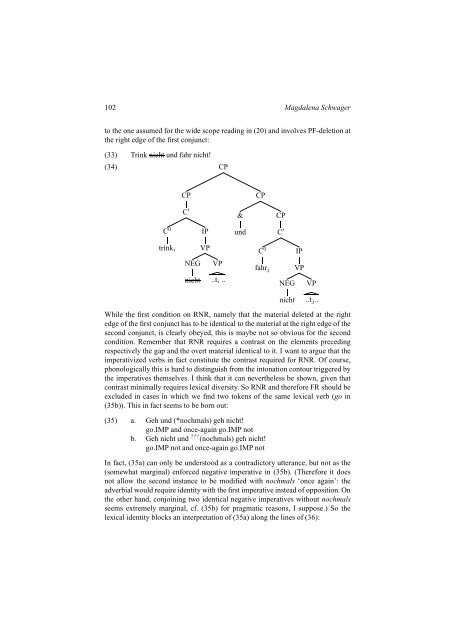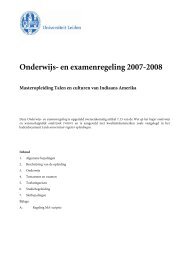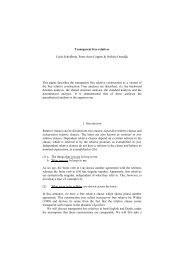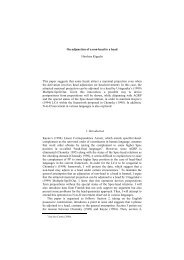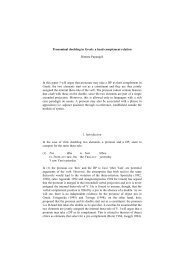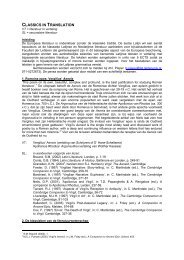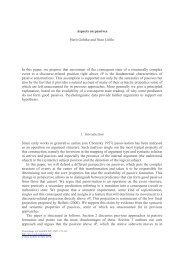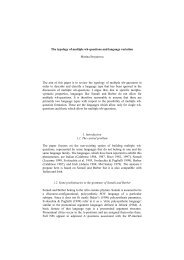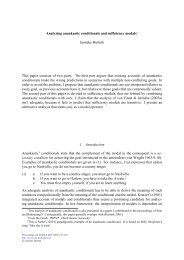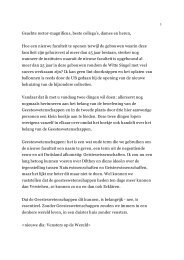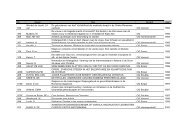Negating and Conjoining Imperatives Magdalena Schwager The ...
Negating and Conjoining Imperatives Magdalena Schwager The ...
Negating and Conjoining Imperatives Magdalena Schwager The ...
Create successful ePaper yourself
Turn your PDF publications into a flip-book with our unique Google optimized e-Paper software.
102 <strong>Magdalena</strong> <strong>Schwager</strong><br />
to the one assumed for the wide scope reading in (20) <strong>and</strong> involves PF-deletion at<br />
the right edge of the first conjunct:<br />
(33) Trink nicht und fahr nicht!<br />
(34) CP<br />
CP<br />
CP<br />
C ′<br />
&<br />
CP<br />
C 0<br />
IP<br />
und<br />
C ′<br />
trink i<br />
VP<br />
C 0<br />
IP<br />
NEG VP<br />
nicht ..t i ..<br />
fahr j<br />
VP<br />
NEG VP<br />
nicht<br />
..t j ..<br />
While the first condition on RNR, namely that the material deleted at the right<br />
edge of the first conjunct has to be identical to the material at the right edge of the<br />
second conjunct, is clearly obeyed, this is maybe not so obvious for the second<br />
condition. Remember that RNR requires a contrast on the elements preceding<br />
respectively the gap <strong>and</strong> the overt material identical to it. I want to argue that the<br />
imperativized verbs in fact constitute the contrast required for RNR. Of course,<br />
phonologically this is hard to distinguish from the intonation contour triggered by<br />
the imperatives themselves. I think that it can nevertheless be shown, given that<br />
contrast minimally requires lexical diversity. So RNR <strong>and</strong> therefore FR should be<br />
excluded in cases in which we find two tokens of the same lexical verb (go in<br />
(35b)). This in fact seems to be born out:<br />
(35) a. Geh und (*nochmals) geh nicht!<br />
go.IMP <strong>and</strong> once-again go.IMP not<br />
b. Geh nicht und ??? (nochmals) geh nicht!<br />
go.IMP not <strong>and</strong> once-again go.IMP not<br />
In fact, (35a) can only be understood as a contradictory utterance, but not as the<br />
(somewhat marginal) enforced negative imperative in (35b). (<strong>The</strong>refore it does<br />
not allow the second instance to be modified with nochmals ‘once again’: the<br />
adverbial would require identity with the first imperative instead of opposition. On<br />
the other h<strong>and</strong>, conjoining two identical negative imperatives without nochmals<br />
seems extremely marginal, cf. (35b) for pragmatic reasons, I suppose.) So the<br />
lexical identity blocks an interpretation of (35a) along the lines of (36):


